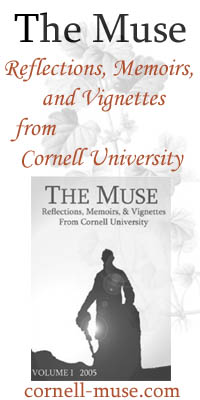 | ||
Archives
|
July 2010
Overenrolled Again; No Waitlist Use For Cornell Class of 2014
We've had our suspicions for the last month or so, but the New York Times recently confirmed the fact that Cornell has yet to take a student off the waitlist this summer. Currently, Cornell has has 3,238 students planning on arriving in Ithaca this August. That's 88 students more than the annual incoming class target of 3,150. What's striking is that Cornell over-enrolled despite all of the bad press about suicides this spring. Just imagine how over-enrolled Cornell would have been had only the Sweet Sixteen (which certainly bumped up enrollment at the margins) occurred. Curious to note the number of schools who have had to rely pretty heavily on their wait list to reach their enrollment targets this summer. Duke took 11 percent (!) of its entering freshmen off the wait list. Vanderbilt took 10 percent, while Columbia and Harvard took 5 percent and 4 percent off its waitlists, respectively. Below, some of the data from the Times: Matthew Nagowski | July 28, 2010 (#) More on Cornell's Suicide Rate MetaEzra reader MP writes in to protest last week's coverage of the fact that Cornell's suicide rate is lower than the national average: You cite CU suicide rates over 21 years. The big 10 study is over 10. Apples, Oranges. And you leave off this gem: "The University of North Carolina at Chapel Hill’s Suicide Prevention Task Force 2004 report indicated that over a five year period seven UNC students committed suicide. This is consistent with the prevalence rates noted above for this size campus." I haven't compared the size of UNC to CU...let's assume they're comparable for a moment. This would create a problem for the idea that the narrative (not the facts) are the problem re:Cornell suicides. Wouldn't you agree? You can normalize and rationalize out to however many student suicide hours per weekend you want. My perception of reality is that people are worried about their friends and family... and that this is not a numbers game. People rightly perceive[d] an escalating number of suicides. Until proven otherwise, the statistics provided by Susan Murphy (as quoted by the Ithaca Journal) reflect responsible journalism. But let's see. UNC has a campus of 30,000 students. 7 suicides over 5 years yields a rate of 1.4 a year. Let's normalize that to a rate per a hundred thousand students years... That gets us to 4.6 suicides per a hundred thousand student years. If that number seems vaguely familiar, it's because that's Cornell's long-term student suicide rate prior to the tragic cluster of suicides this spring. Taking a step back, from the numbers, however, nobody's arguing about whether or not there was an escalation of suicides this spring. There was a tragic clustering of suicides that could have precipitated even more tragedies had the administration not have reacted as strongly as it did. The cluster that we experienced was simply awful, but that doesn't mean that Cornell itself has a suicide problem. Suicide clusters can happen anytime and anyplace. Statistics are great when they are used within context and with a scientific approach. However, when we're just quoting numbers at random and without any underlying approach to rationally compare things it's easy to get numbers to look like you want them to look. So yes, Cornell did have six suicides in one year, and UNC did have seven suicides over the course of five. But Cornell also has has six over the last four. You can slice and dice it a lot of different ways to conform to your world views. But if we want to take a scientific approach to this, we should know that for rare events like suicides or murders, numbers are always quoted on a per 100,000 basis as that's the minimum sample size you need in order to make comparisons. A town of 10,000 with one murder in any given year (but none in the next nine) certainly doesn't have a higher long-term rate of murders than a city of 100,000 with one murder a year. See for example, this research piece by the CDC which quotes death rates nationwide on a per 100,000 basis. So I rest my case. People are rightfully worried about their friends and their loved ones at Cornell given the events of this spring. And one way to help friends and family is to help fight the myth that Cornell is a suicide school. Because, well, it's not. And we certainly don't want the myth to become a reality. It would be a sad day if Cornell started considering itself a suicide school (despite all evidence to the contrary) and it became more socially acceptable for Cornell students to take their own lives. That would be the worst outcome of all. Matthew Nagowski | July 27, 2010 (#) Cornell's Suicide Rate: Still Lower Than Average From the Ithaca Journal, we finally get some hard data on Cornell suicides over the last 21 years: Of those 29, 15 were Cornell students, 10 were members of the Ithaca community, and four were people from out of town, she said. In the past 21 years, Cornell has lost 25 students to suicide, by all means, Murphy said. So let's do the math on this one: Cornell has had a suicide rate of 1.2 per year over the last 21 years, or 6 suicides per 100,000 student-years.. By comparison, the national average suicide rate for college students (which is traditionally reported as the result of this Big 10 study) is 7.5 per 100,000 student-years. And of course, prior to the tragedies of this year, Cornell's suicide rate over the last two decades was 0.9 per year, or 4.5 per 100,000 student-years. That's significantly lower than the national average, and probably where the number will trend back down to over time. Also interesting to point out that 60 percent of Cornell student suicides have been gorge deaths, but that Cornell students represent only half of gorge suicide attempts. This is why we need facts, not mythology, on suicide. The myth of Cornell suicides is much greater than the reality. It's just that jumping into a bucolic gorge is a rather stunning way to go. In other news: The Ithaca Common Council granted permission for the current chain link fences to remain in place until August. Cornell is now asking to install interim barriers that university officials believe are more aesthetically pleasing. The barriers would be in place while the city and Cornell develop permanent solutions. Courtesy of the Cornell Chronicle, here's a picture of the new fencing.  Lovely. Matthew Nagowski | July 17, 2010 (#) Color Blind Mentoring Back in March, when the University was reeling from three undergraduate suicides in the span of a month, President Skorton made certain that students "knew how to ask for help". Meanwhile, the alumni body, frazzled and frayed by such tragic news, went to work brainstorming possible remedies for the Cornell community. So an expansion of one of our school's little gems of a program might be in the cards given the tragedies of the spring. The Alumni-Student Mentoring Program offers: Sounds like a good program, no? There's only one small problem: Not only that, but it doesn't appear that the program does any recruiting of students or alumni outside of these ethnic groups. It's pretty telling that myself, a pretty engaged alumnus who works a lot with admissions, alumni affairs, and various other on-campus departments has not once received any correspondence about this program.* And that includes an exhaustive search of my email archives back to 2004. Now, I can understand why the program may have originally started as being geared towards ethnic minorities -- on average students from those backgrounds probably could benefit from a mentor more than the average white student. But that's not to say that a white student from an impoverished background, a broken home, or dealing with certain other issues (e.g. homosexuality, academic stress, or feeling out of place on campus) couldn't have a strong need for an alumni mentor as well. After all, it was three white students who took their own lives this spring. Not that I should directly tie the lack of this program for white students to the tragedies of this spring. That's a bit unfair. But it's fairly unfortunate that an ostensibly great program -- one that has the potential to build a lot of good will among alumni and to improve the Cornell experience for students -- isn't color blind. *N.B. For those of you who think I am Asian, that surname at the bottom of the blog post is Polish-Catholic. Not Japanese. Matthew Nagowski | July 17, 2010 (#) Summertime and the Blogging Is Easy A current take on the 161 things every Cornellian must do. It's still blasphemous that the current list doesn't require one book to read. And a guitar-driven rendition of the Alma Mater to heat up your summer nights: Matthew Nagowski | July 12, 2010 (#) Cornell's Wisconsin Gambit No, we're not talking about Biddy Martin. That was so two years ago. As The Chronicle's blog, The Essentials, picked up today, Daniel Mansoor '79 has started a blog detailing the specifics of Ezra's original land grant of prime Wisconsin forests as part of the Morril Land Grant Act. He calls it In Search of Ezra's Pines, and the blog is apparently an aid in a book project on the same fascinating topic. Given that we're dyed in the wool Cornelliana buffs here at MetaEzra, we'll be eagerly reading Mansoor's work. And he left us with one tantalizing nugget of speculation: What are mineral rights? “It is the right of the owner to exploit, mine, and/or produce any or all of the minerals lying below the surface of the property.” Ok – now I’m just being annoying – but if Cornell still holds the mineral rights to, say, 25% of the original 500,000 acres, and this land yields a mere one one-hundredth of the Flambeau Mine totals, these holdings would be worth $40 billion. $40 billion would put the $330 MM of the Marcellus Shale deposits to shame. And most other university endowments in the world. Matthew Nagowski | July 06, 2010 (#) |
-- WSJ: Cornell Wins NYC Tech Campus Bid (EBilmes) -- Barrier Update: City Approves Nets (DJost) -- Big Red Cymbal Guy (Nagowski) -- New York Times Survey on Campus Recruiting is Flawed (KScott) -- Barrier Update: Legal precedent suggests City of Ithaca will not be held liable for gorge suicide (DJost) -- Despite MSG Loss, Big Potential for Big Red Hockey (EBilmes) -- City Council Will Vote on Suicide Nets (DJost) -- An Encounter on the Upper East Side (Nagowski) -- Showing Off Your School Spirit (Nagowski) -- Chipotle Ithaca? (KScott) -- Cornell at the ING NYC Marathon (KScott) -- Crossing Over a Fine Line: Commercial Activity on Campus (KScott) -- Milstein's Downfall (Nagowski) -- Can any Cornell-associated organization really be independent of the University? (Nagowski) -- Slope Media Revisited (EBilmes) -- Slope Media Group Approved for Byline Funding (KScott) -- Occupy AEM? (KScott) -- New campus pub to be good for both Greeks and non-Greeks (Nagowski) -- Gagging the Election (Nagowski) -- The Changing Structure of Rush Week (Nagowski) -- Ivy League Humility in the Midwest (EBilmes) -- Of Median Grades and Economics Minors (Nagowski) -- Homecoming Recap (Nagowski) -- My Cornell Bookshelf (Nagowski) -- The Sun's Opinion Section Has Suddenly Gotten Good (Nagowski) -- Remembering the 11th (Nagowski) -- Cornellian Tapped as Top Economic Advisor (Nagowski) -- Cutting Pledging, and the Good Which Comes With It (EBilmes) -- Why Cornell Should Not Close Fall Creek Gorge (Nagowski) -- Welcome to the Class of 2015 (Nagowski)  |